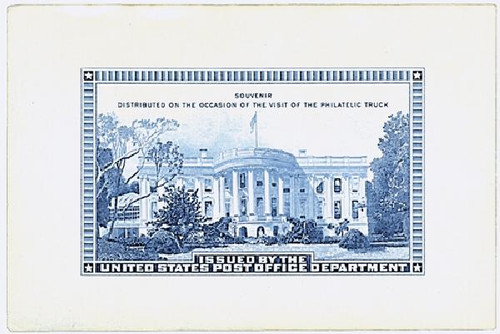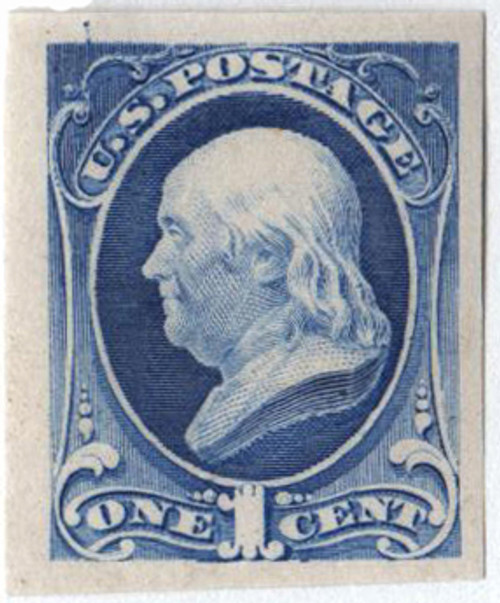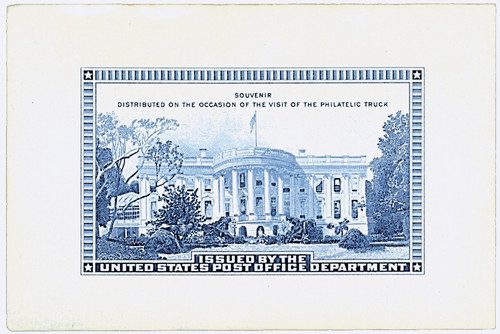Philatelic Truck Begins its Journey
Philatelic Truck Begins its Journey
On May 9, 1939, the Philatelic Truck departed the White House on a cross-country journey to introduce thousands of Americans to the exciting world of stamps.
The Philatelic Truck was the brainchild of stamp-collector President Franklin Roosevelt. He ordered the traveling exhibit to show Americans how stamps were made. The first public mention of the truck was in an August 1938 article in The New York Sun that stated the truck’s purpose was to “stimulate interest in stamp collecting among the youth of the country.”

The truck was a custom-made armored vehicle that served as a mobile philatelic museum. It carried specimens of every US stamp issued from the 1847 Franklin and Washington issues to those issued at the time of the tour. The tour officially began on May 9, 1939, with a special ceremony at the White House. After that, Postmaster General James A. Farley performed his final inspection of the truck before it set out on its journey.

Over the next 28 months, the truck traveled the nation stopping at hundreds of schools, libraries, and other sites. Visitors to the truck got to see dies and plates used to make stamps as well as a set of die proofs. In the center of the truck was a miniature Stickney printing press. The press simulated the printing of souvenir sheets that were slowly rolled out and cut for each visitor to take home. In reality, these sheets had been pre-printed by the Bureau of Engraving and Printing in large rolls. Over time though, the truck’s operators found that the press moved too slowly to efficiently hand out the souvenir sheets to the large crowds, so they began handing out pre-cut cards.
Additionally, the cards handed out during the first year were gummed. But soon, people began finding the sheets stuck to windows, cars, and even the truck itself, they began producing the sheets ungummed. The gummed cards are much harder to find today than the ungummed. Young visitors also had the opportunity to purchase a book produced specifically for the tour for 10¢ – A Description of United States Postage Stamps – Junior Edition.
Visitors to the truck also had the option to mail out letters right there. If they wanted, they could use special envelopes produced specially for the Philatelic Truck. The truck also made a special stop in 1940, at the 46th Annual Convention of the Society of Philatelic Americans. People who visited the truck at this convention received a scarce variety with an overprint marking the convention, which you can view here.

On an average day, about 800 people would usually get to visit the truck. Reportedly, the largest visitation occurred in Pittsburgh, Pennsylvania, on Labor Day. The truck was parked at the city’s fairgrounds and was visited by about 5,000 people.

After more than two years of traveling, the philatelic truck’s journey was cut short by the Japanese attack on Pearl Harbor on December 7, 1941. The truck was rushed from Yuma, Arizona, to its final stop in San Diego, California, on December 12, 1941. There, the exhibits were removed and sent back to Washington, D.C. The truck itself was reportedly left at the Rincon Annex of the San Francisco Post Office. During its trip, the truck had traveled 20,750 miles, visited 490 towns, and had 483,976 visitors.
Click here to see a photo of the truck on the first day of its journey.
Click here to see what else happened on This Day in History.


My thinking, why youth not interested in Philately is that Internet and email changed our living. Also too many new stamps are produced by so many countries every year. Rarity is gone. Only great thing is Art work and great quality printing of the current issues. To me each stamp is a miniature work of art and eager to tell the story behind the stamp. I like to see the revival of interest in this great hobby. New FDR, where are you. Please activate. Mystic does a great job to keep the interest for persons like me.
I wish they could do something like this today.
WOULDN’T THAT BE AWESOME IF THEY COULD DO IT TODAY!
Another interesting slice of American history. It would be wonderful to bring something like this back to get more people interested in stamp collecting. Thank you FDR for this wonderful idea and thank you Mystic for letting me know about it.
I agree with our first responder. I am tired of dinosaur,Mickey Mouse and fake commemoratives from countries that have nothing to do with the subjects on the stamps….eg. Astronauts or European events on stamps from Togo or Grenada.That is junk. Stamps used to depict important historic events and how a nation presented itself to the world….either in a positive or even threatening way.
I agree with Brian, it was more fun in the early days of collecting when we were not deluged with too many stamps. I don’t even try to keep up now. I’ll collect what I can. I appreciate Mystic and it’s efforts on behalf of stamp collecting.
I think as to US stamps the forever stamp really dulled my collecting interest. I mean since a small boy I was always interested in stamps especially those which were of a higher denomination. The “forever” domination on a stamp makes me think it is just like a Cinderella.
Thank you for a very informative article. I agree with those who have given up on collecting US stamps. No one can expect to keep up with the deluge of US stamps today, and they acquire no value to speak of, with certain exceptions, such as high face values.
Ah, the glory days of stamp collecting in America was during FDR’s lengthy term in office and for that generation of collectors.Thank you Mystic for recalling those glory days. The rapidly increasing cost of postage, as well as computerized mailing and the pre-gumming of stamps have just about killed the hobby for new collectors. But, it’s still fun!
What an example for us stamp collectors like FDR was….when it does come to collections it should come what the enjoyment it gives…not the rarity…I’ve seen many times the so called “cut off ” dates in terms of production….all one needs to do is go to a marketplace like Ebay and see how common those stamps are….perhaps in condition yes….rarity no…we should follow FDR’s example….collect for the enjoyment and sheer beauty they give…the history and artwork they provide….